Wait..we know about Menopause, but what’s Andropause?
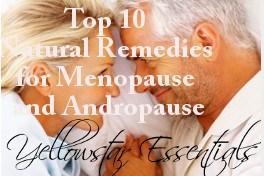
As with female menopause, the underlying cause of andropause is the decrease in production of naturally occurring hormones within the body. Age takes its toll on everyone, and a decrease in hormone production over time is common to both men and women. Testosterone levels in men begin to decrease as early as age 30, and continue to decline at an estimated 1% per year through the age of 50 and above. Same with progesterone levels in women.
So Andopause is just the male version of Menopause…(who made that name up, I don’t have a clue). Here’s a side note from Wikipedia about it: ——>
The term “symptomatic late onset hypogonadism” (or “SLOH”) is sometimes considered to refer to the same condition as the word “andropause”.[34][35]
Some researchers prefer the term “androgen deficiency of the aging male” (“ADAM”), to more accurately reflect the fact that the loss of testosterone production is gradual and asymptotic[36] (in contrast to the more abrupt change associated with menopause.[37]) The “D” is sometimes given as “decline” instead of “deficiency”. In some contexts, the term “partial androgen deficiency in aging males” (“PADAM”) is used instead.[38]
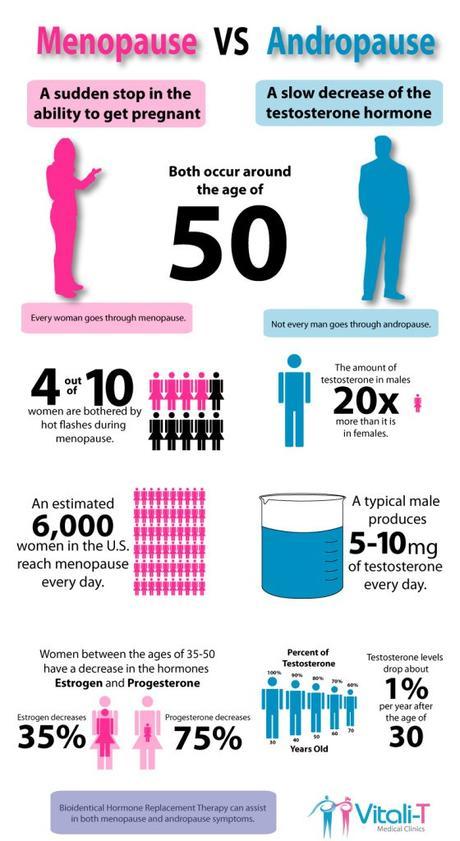
OK…back to the task at hand.
We all know that sugar, caffeine, alcohol, stress, and lack of exercise all contribute to worsening symptoms of menopause, PMS, Andropause and almost every other health issue. I never said it was easy, but hey, it must be said—it’s the truth.
But there is some good news, it doesn’t have to be all bad. Read on for more natural remedies to help both women and men with menopause or andropause.
#1 : Exercise
Alright, I know I’ve already mentioned it, but c’mon….it’s really the best thing you could do for yourself, no matter your age or affliction. As with almost every natural remedies list I’ve ever seen, this one too begins with the number one health booster—> exercise.
No one wants to hear it, and most don’t do it enough. But if you’re looking to get healthy or reduce issues with your body, movement is key. Exercise gets things moving again. It doesn’t matter what type of exercise you do as long as your body gets warmed up, with a raise in your heartbeat for at least 20 min., and a cool down period at least 5 days a week. Just do what you love, whether it’s walking, dancing, hiking, swimming, some kind of sport…whatever. Just check with your doctor first. Exercise is vital to life. You stop moving, you stop living.
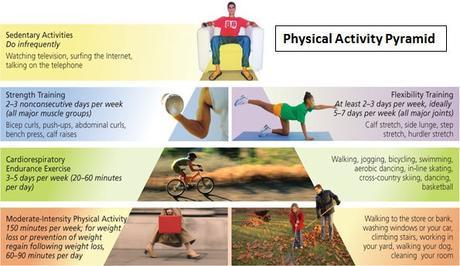
360wellnesslab.com
#2: Flaxseed
Ok, now for some better news for those that don’t enjoy hearing about what you can’t have, or tired of the negatives associated with menopause and andropause. Susan Moores, (a registered dietitian) says, “Flaxseed falls in the same camp as soy for the phytoestrogens”. One study by the Mayo Clinic found flaxseed could reduce hot flashes as much as 50%. (Men can get hot flashes too).
Flax seeds contain lignans that help balance hormone metabolism and block the negative effects of excess estrogens. Not only is flaxseed good for hormone balancing from phytoestrogens, it also contains omega-3 fatty acids, which can aid in mood stabilization, and is excellent for heart health, skin, nails, and hair. A must-have in your health arsenal.
Eating flaxseeds also increases fiber in your diet which is a great thing, but make sure to also get lots of fiber from vegetables, fruit, nuts, seeds, beans, and whole grains. Two tablespoons of ground flax seeds a day are especially helpful in correcting constipation and balancing hormones. Put them in a shake or sprinkle them on salads or food. If you can’t have them or don’t like them take a supplement. I found some great Flaxseed oil with Omega 3 6 9 at Amazon for a great price..

#3:Black Cohosh
Another great supplement in your herbal arsenal –>Black Cohosh’s effects were first discovered by Native Americans. From its introduction to early settlers until today, Black Cohosh remains a popular and effective supplement for a variety of hormonal problems.Two German studies have shown black cohosh to be effective in reducing hot flashes, according to A.D.A.M. One study in particular showed 80 percent of women saw a decrease in hot flashes while using black cohosh. However, no long-term studies have been done and there have been reports of side-effects including upset stomach and low blood pressure, caution the experts at Harvard Medical School.
#4:Wild Yam
Some women apply wild yam creams to the skin to reduce menopausal symptoms such as hot flashes. “Skin creams that contain extracts of Mexican wild yams have been widely promoted for natural menopause relief for years,” says Harvard Medical School. However, because of variation among products and the individual nature of skin’s responsiveness, this method is not recommended by the North American Menopause Society, says Harvard. There’s no safety data on this hormone, Dr. Richardson cautions. Learn more about the risks and benefits here.
Dr. John R. Lee has observed that natural Mexican wild yam cream gives great relief to men with prostate problems. Their nightly visits to the bathroom ceased, and their energy levels went up. Animal studies have corroborated these results, and studies with humans are on the way.
Wild yam is a plant. It contains a chemical, diosgenin, which can be made in the laboratory into various steroids, such as estrogen and dehydroepiandrosterone (DHEA). The root and the bulb of the plant are used as a source of diosgenin, which is prepared as an “extract,” a liquid that contains concentrated diosgenin.
There are over 600 species of wild yam. Some species are grown specifically as a source of diosgenin for laboratories to use in making steroids. These species are generally not eaten due to a bitter flavor. Only about 12 of the 600 species are considered edible.
Diosgenin or wild yam is often promoted as a “natural alterative” to estrogen therapy, so you will see it used for estrogen replacement therapy, vaginal dryness in older women, PMS (premenstrual syndrome), menstrual cramps, weak bones (osteoporosis), increasing energy and sexual drive in men and women, and breast enlargement. Wild yam does seem to have some estrogen-like activity, but it is not actually converted into estrogen in the body. It takes a laboratory to do that.
Similarly, you will also see wild yam and diosgenin promoted as a “natural DHEA.” This is because in the laboratory DHEA is made from diosgenin, but this chemical reaction is not believed to occur in the human body. So taking wild yam extract will not increase DHEA levels in people. Individuals who are interested in taking DHEA should avoid wild yam products labeled as “natural DHEA.” Wild yam is also used for treating a disorder of the intestines called diverticulosis, gallbladder pain, rheumatoid arthritis, and for increasing energy.
#5: Less Dairy (I know…ugh!)
We know that sugar, caffeine, alcohol, stress, and lack of exercise all contribute to worsening PMS, and menopause. It is also true that dairy consumption can worsen hormonal imbalances because of all the hormones in milk. But note that Calcium and Vitamin D supplements are especially important for women.
#6 Chasteberry; Chasteberry fruit extract (Vitex Agnus-astus)
Chasteberry fruit extract (Vitex Agnus-astus) can help balance the hormones released by the pituitary gland that control your overall hormone function. Studies of over 5,000 women have found it effective. Take 100 mg twice a day of a 10:1 extract.
#7 Xiao Yao San (Rambling Powder)
Chinese herbal formulas may also help. One of the most effective is Xiao Yao San, or Rambling Powder. It contains: Bupleurum Root (Bupleurum chinense), Chinese Peony Root (Paeonia lactiflora), Dong Quai Root (Angelica sinensis), Bai-Zhu Atractylodes Root (Atractylodes macrocephala), Poria Sclerotium (Poria cocos), Ginger Rhizome (Zingiber officinale), Chinese Licorice Root (Glycyrrhiza uralensis),and Chinese Mint Leaf (Mentha haplocalyx)
#8 Probiotics
Replacing healthy bacteria in the gut also helps normalize hormones and hormone metabolism. Take 5 to 10 billion live organisms in a daily probiotic supplement.
Beneficial flora metabolize and recycle hormones, including estrogen, thyroid hormones, and phytoestrogens from food sources, which can help offset symptoms of menopause, PMS and perimenopause. In this way, they help maintain proper hormonal balance, and may protect bone and breast health as well. There is evidence that some probiotics may have anti-tumor, anticancer effects by helping us metabolize specific food components (like antioxidants and flavonoids) into useable forms.
#9 Eliminate or Lessen Stress!
Stress is a nasty detriment to you health, no matter your stage in life. And whether you are juggling with home issues, financial issues, family issues, menopause, andropause or just life; dealing with stress is critical. Try destressing your life as much as you are able at least once per day. These techniques and others can help balance hormones.Try these methods:
- draw a hot bath at night with essential oils,
- get a massage with these essential oils,
- try yoga, learn deep breathing or meditation.
#10 Try Alternative Therapies
Therapies such as acupuncture and homeopathy may help. One clinical trial showed that individualized homeopathy is effective in treating PMS. Others work well for menopause and andropause as well as many other health issues. Five homeopathic medicines were used for women with menopause or PMS: Lachesis, Natrum muriaticum, Nux vomica, Pulsatilla, and Sepia Talk to your homeopathic doctor for more info.
Supplement superstars for menopause, andropause and PMS:
- Magnesium citrate or glycinate — Take 400 to 600 mg a day. (men and women)
- Calcium citrate — Take 600 mg a day.(men and women)
- Vitamin B6 — Take 50 to 100 mg a day along with 800 mcg of folate and 1,000 mcg of vitamin B12. (men and women)
- Evening primrose oil — Take two 500mg capsules twice a day.(women)
- EPA/DHA (omega 3 fats) — Take 1,000 mg once or twice a day.(men and women)
- Taurine — Take 500 mg a day to help liver detoxification. (men and women)
- A good daily multivitamin (men and women)
- Vitamin E; There has been a study, which showed a slight effect in decreasing hot flashes for women using vitamin E, says Dr. Marcie Richardson. Along with reducing hot flashes vitamin E may carry with it extra benefits, such as fending off macular degeneration, lowering blood pressure, and slowing the aging of cells and tissues according to A.D.A.M.
- For intractable cases of menopause, or PMS, occasionally use topical, natural bioidentical progesterone in the last two weeks of the menstrual cycle. The usual dose is 1/2 tsp (20 to 40 mg) applied at night to thin skin areas for the last two weeks of the menstrual cycle (or when it would have been for menopause).
Other herbal supplements that may help with menopause:
- Damainia (Turnera diffusa or Turnera aphrodisiaca)-see below
- Oat Straw
- Dong Quai (Chinese Angelica)
- Red Clover
- Dandelion root- Dandelion root can help with liver detoxification and works as a diuretic.
- Isoflavones from soy, red clover, or kudzu root improve estrogen detoxification by boosting the activity of specific detox enzymes. They can be taken as supplements or consumed in the diet.
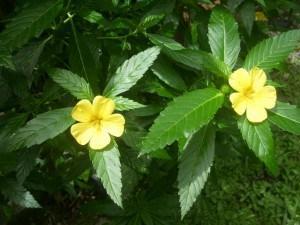
Damaina is legal to grow, buy, sell, own, and use in most places. However it is restricted in Louisiana as of 2005.
Damiana (Turnera diffusa or Turnera aphrodisiaca) is a woody plant with several stems that grows in hot and humid parts of Mexico, Central and South America. It can also be found under such names as “herba de la pastora,” “Mexican damiana,” and “old woman’s broom”. Having been first introduced in the USA in 1874, Damiana herb has a long and interesting history of use in the folk medicine. Damiana has been long used as a relaxant and aphrodisiac. Native Mexican Indians were known to drink sweetened Damiana tea and it is believed to be one of the original ingredients of margaritas.
The use of Damiana as an aphrodisiac has continued into modern times. In fact, recent studies have shown that it does cause an increase of sexual activity in rats, though it has yet to be scientifically tested on humans. Damiana is used both for its libido stimulating effects as well as for the somewhat narcotic effect it causes. The effect of the tea is believed to be similar to the high obtained from smoking marijuana but milder.
The indigenous population praises the plant for its antidepressant, diuretic, tonic, hypoglycemic, and antibacterial properties. Ancient Mayas and Aztecs used Damiana as a general tonic to improve health condition.
Ancient people thought that Damiana was effective in raising libido, calming nerves and relieving depression and anxiety. They smoked plant’s leaves to relax. Smoking Damiana is practiced even nowadays. Some researchers say that the effect from smoking the herb’s leaves on human brains is similar to the influence of cannabis.
It is interesting to note that boosting sexual desire is not the only property of Damiana. Native tribes also use it to treat constipation and digestive problems, as well as gastric ulcers, menstrual irregularities, and bed-wetting. Although it is widely used, scientific support for the benefits of this herb are lacking.
Chemical structure of Damiana is rather complicated. The herb is rich in many active components that account for its main medicinal uses and applications. One of the main constituents is volatile oil that is found in the leaves of Damiana. This oil consists of at least 20 elements, including 1.8-cineole, p-cymene, alpha- and beta-pinene, thymol, alpha-copaene, and calamene. The leaves are also a source of flavonoids, tannins, damianin, beta-sitosterol, arbutin.
Damiana can affect blood sugar levels. If you have diabetes, check your blood sugar carefully. Damiana is not recommended for people with diabetes, a history of breast cancer, Alzheimer’s, Parkinson’s or other psychiatric disorders. It should not be used by women who are pregnant or breastfeeding. Talk to your doctor before using any herbal supplement to see if it interferes with any medication you take.
Oatstraw:
Oat Straw ranks among the most important restoratives for conditions of the central nervous system. Because of its selective action upon the nervous structure which supplies the reproductive organs, it will be found to allay nervous excitement, nervous palpitation of the heart, insomnia and mental weakness. It has been shown to have a positive effect upon male impotence.
Research indicates that Wild Yam is a powerful alternative medicine containing many steroidal saponins, mainly Dioscin which is widely used to manufacture progesterone and other steroid drugs used as contraceptives and in the treatment of various disorders of the genitary organs as well as in other diseases such as asthma and arthritis. Other constituents Phytosterols (beta-sitosterol), alkaloids and Tannins make this plant useful as an antiinflammatory, antispasmodic, cholagogue, diaphoretic and vasodilator. A decoction of the root is used to alleviate many of the symptoms of menopause and PMS such as hot flashes, night sweats, mood changes, and vaginal dryness. It is also used to treat irritable bowel syndrome, gastritis, gall bladder complaints, spasmodic cramps, painful menstruation, and in small doses is especially helpful in treating the nausea of pregnant women.
Red Clover:
Red clover is often used to reduce vaginal dryness and decrease hot flashes. The effectiveness of red clover is thought to be due to a plant-chemical, isoflavones, which has an estrogen-like effect in the body. However, according to Harvard Medical School, research results have been disappointing. Two studies published in the journal ‘Menopause’ found that women fared no better with red clover than a placebo for both hot flashes and vaginal dryness.
Resources and More Reading:
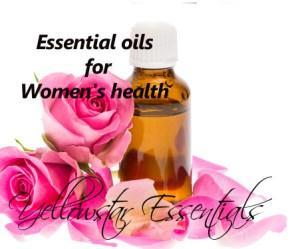
https://yellowstaressentials.wordpress.com/2010/04/03/essential-oils-for-menopause/
Essential Oils and natural remedies for Menopause
Mark Hyman, MD article
natural approach to male menopause:
Herbal supplement guide/ damiana
chinese herbs damiana;
massage oil recipe to help with menopause or andropause
essential oils to add to your bath for menopause or andropause
